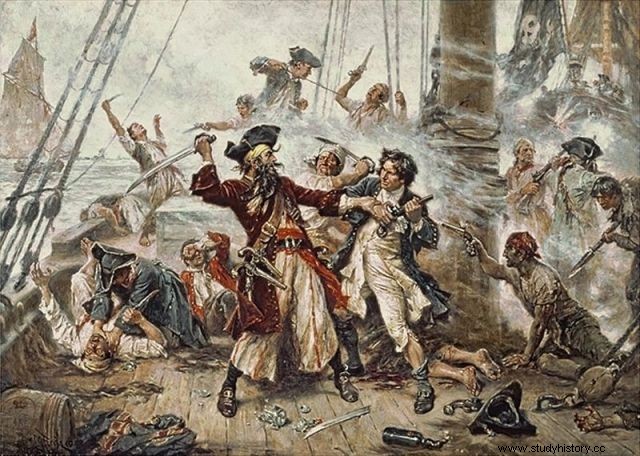The movies got us used to the image of the pirate as a cute, if somewhat crude brawler. Unrestricted freedom, tropical holidays, a girl in every port ... There is not much truth in this vision. Pirates paid for freedom with a noose, malaria raged in the Caribbean, all suffered from rheumatism and died before the age of 30.
Life in the seas in the 18th century was nasty and short. Every adept at pirate craftsmanship knew that the specter of imminent death was hanging over him. Let us take an example. When the crew of the legendary Bartholomew Roberts was finally reached by the arm of justice (at Cape Coast Castle in West Africa in 1722) authorities described the pirates as "old sea wolves and recidivists."
30 Year Vets in the Industry
This does not mean at all that they were really old or experienced people. The oldest was in the pirate business for barely ... four years. Most have been flying the black flag for less than two.

Is the life of a pirate beautiful? Only in movies ... and games (excerpt from "Age of Pirates II" promotion graphic).
In turn, the average age of a pirate in the so-called The "golden age of piracy" was about 27 years. Thomas Hazel hung in his 50s and was one of the oldest pirates ever heard of.
Perhaps the luxurious rulers and aristocrats lived to be ninety in this era, but among the pirates, thirty was already the retirement age.
The voice of the first is in your ears, paws are scratched to blood
Life on a pirate ship was not easy. A crowded, smelly cubicle waited for the pirates, where they slept briefly, in wet, salt-covered clothes.
Hands covered open wounds from constantly climbing and pulling on rough ropes in which salt was additionally eaten. The bellies, on the other hand, were bloated from carrying heavy loads (hernia!).
In addition, everyone suffered from rheumatism from constant wetness. In the north, everyone was freezing, while in the tropics, the scorching sun made the skin peel off the body, sores and cracking scabs appeared.
Of the entire crew, one was left out, though forty-two of them emerged ...
Infectious diseases were the nightmare of pirate life. It is not surprising when a dozen or so peasants lived together in a cramped space for many months in the company of rats, lice and cockroaches. Gottlieb Mittelberger, who traveled the Atlantic in 1750, wrote that the cabins were places:
(...) foul, stuffy, frightening, nauseating, with various diseases and it was easy to get fever, dysentery, headache, stroke, consumption, boils, scurvy, cancer, oral rot and the like, all because of old, salted food and meat, as well as contaminated, stale water that takes its bloody toll on ships.
The food was actually lousy:salted beef and pork, which was the staple of the diet at sea, often moldy, rotted and wormy . As Colin Woodard writes in the recently published book "The Pirate Republic", it was eaten with eyes closed, because there was simply nothing else.

Capturing Blackbeard. 20th century illustration.
It was no better with water - this after a few weeks of storage in wooden barrels green. And the dysentery epidemic is ready. It was probably dysentery that decimated the crew of Captain Woodes Rogers - vice admiral and governor of the Bahamas, and previously a privateer in British service. When he arrived in Nassau, he suffered from enteritis and was severely weakened.
HMS Milford's logbook records the deaths of the doctor, the boatswain and two of the crew only two days after mooring. And in the first report to London, Rogers wrote about 86 soldiers, sailors and passengers who died as a result of the epidemic.
Yo-ho ho and a bottle of… quinine
There was also malaria, which many people in Africa were resistant to, and which massively mowed white newcomers. About mosquitoes it was written: troublesome devils biting through clothes . But the state of medical knowledge was primitive at the time, and no one linked insects to the disease. Outbreaks broke out one after another.
The fever usually starts with severe pain and dizziness - wrote the surgeon of the Royal Navy, reporting the malaria epidemic in Africa in 1721. - Then comes nausea, vomiting and anxiety. The patient begins to sweat heavily, is exhausted by thirst and passes urine passively . Then he is either delirious or convulsed or he loses his speech .
This article has more than one page. Please select another one below to continue reading.
Blackbeard also had Francois (and Yellow Fever)
Dysentery (dysentery) and yellow fever were also common, and by sailing up the rivers to the delta it was possible to fall into "river blindness". Leprosy awaited in some parts of the world, and parasitic diseases were common, such as the hookworm found throughout the subtropical zone. Syphilis was spreading in pirate circles like a runny nose in kindergarten, and it was hard to find anyone on Tortuga who hadn't caught it yet.
Even the most terrible of pirates, the legendary Blackbeard, did not resist disease. During a daring attack on South Carolina's richest port, Charles Town (now Charleston) in 1718, one of his main demands was ... a chest full of medicine worth around £ 400.
Presumably the captain and his crew caught syphilis during their winter stay in Hispaniola (former Haiti name) or yellow fever in Honduras.

Such pirates are only in movies…
Happy is the life of an old man
Years of indulging various appetites took their toll on old age. One of the lucky few who lived to see her was Sir Henry Morgan. For hectoliters of rum drunk (and there is even a brand named after him) and intoxicating nights in brothels he paid for with gout, cirrhosis and atherosclerosis.
They caught up with him before he was fifty when he was retiring as governor of Jamaica. We know about it from the records of the doctor who looked after the former pirate in the last year of his life:
Sir Henry Morgan:approximately 45 years old [in fact 53], thin, sallow skin
yellowed eyes, bloated stomach, complained of a lack of appetite for food; had nausea or vomiting every morning and general dizziness.

The article is based, among others, on the book "The Pirate Republic" by Colin Woodard.
Captain Morgan died exceptionally in his own bed. Most pirates died at sea, in battle, or on the gallows, which was part of their trade. And few were under the illusion that a light, easy and pleasant life awaited them.
Bartholomew Roberts used to say that in honest service, poor food, low wages, and hard work, but the only danger of piracy is the prospect of a noose. And he was willing to accept it. My motto is a short but happy life - summed up the charms of piracy.
